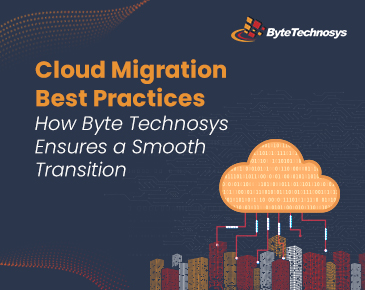
In today’s digital landscape, IT infrastructure management is the backbone of modern businesses, ensuring seamless operations, data management, and security. Whether a small startup or a large enterprise, managing IT infrastructure effectively is crucial for optimizing performance, reducing risks, and enhancing scalability. This guide explores IT infrastructure management, its key components, types, importance, challenges, and future trends.
Understanding Cloud Backup and Disaster Recovery
What is Cloud Backup?
Cloud backup is a system that automatically stores copies of important data in a remote cloud-based server. This method ensures that data is accessible and retrievable in case of accidental deletion, corruption, or cyberattacks. Cloud backups are encrypted, regularly updated, and allow businesses to maintain multiple versions of files for added security. Leading providers like ByteTechnosys offer comprehensive cloud backup services, ensuring businesses have secure and scalable solutions for their data protection needs.
What is Disaster Recovery?
Disaster recovery (DR) refers to a broader strategy that enables businesses to restore critical systems and applications after a major failure or disaster. Unlike simple backups, DR solutions focus on minimizing downtime by quickly reinstating IT infrastructure. Disaster recovery plans often include backup restoration, alternative operational sites, and automated recovery protocols to ensure business continuity.
The Risks of Data Loss for Businesses
Data loss can have severe consequences for businesses, including:
- Financial Losses – Downtime and lost productivity can result in significant revenue decline.
- Legal and Compliance Issues – Breaches of sensitive data may lead to legal penalties and regulatory fines.
- Reputation Damage – Loss of customer trust and confidence can impact long-term business success.
- Operational Disruptions – Employees may struggle to perform essential tasks without access to critical data and systems.
How Cloud Backup Prevents Data Loss
Cloud backup plays a crucial role in safeguarding business data by:
- Ensuring Automated & Continuous Backups – Reducing the risk of data loss due to manual errors or negligence.
- Providing Version Control – Enabling businesses to recover previous file versions in case of accidental overwrites or corruption.
- Offering Offsite Protection – Safeguarding data against localized disasters like fires, floods, and theft.
- Enhancing Security – Encrypting stored data to prevent unauthorized access or cyber threats.
The Role of Disaster Recovery in Business Continuity
Disaster recovery ensures minimal downtime and fast restoration of business functions after an unexpected disruption. Key aspects include:
- Rapid Restoration of Systems – Quickly bringing operations back online after a failure.
- Minimizing Downtime – Reducing revenue losses and maintaining productivity.
- Different DR Strategies:
- Hot Sites – Fully operational backup environments that provide immediate switchover.
- Warm Sites – Partially equipped sites requiring some configuration before resuming operations.
- Cold Sites – Basic backup sites that take longer to set up but are cost-effective.
Key Benefits of Integrating Cloud Backup and Disaster Recovery
Combining cloud backup with disaster recovery offers several advantages:
- Cost-Effectiveness – Reduces the need for expensive on-premise infrastructure.
- Scalability – Easily adapts to growing business needs and increasing data volumes.
- Regulatory Compliance – Helps businesses meet data protection and security regulations.
- Improved Security & Reliability – Ensures data remains protected against cyber threats and system failures.
Choosing the Right Cloud Backup and Disaster Recovery Solution
When selecting a cloud backup and disaster recovery solution, businesses should consider:
- Security & Encryption Standards – Ensuring data remains confidential and protected.
- Scalability & Flexibility – Adapting to future growth and evolving business needs.
- Recovery Time Objectives (RTO) & Recovery Point Objectives (RPO) – Defining acceptable downtime and data loss thresholds.
- Vendor Reputation & Support – Choosing reliable providers with proven track records in data protection and disaster recovery. ByteTechnosys offers industry-leading cloud backup and disaster recovery solutions tailored to business needs, providing secure, scalable, and efficient data protection services.
Conclusion
In an era where data loss can be devastating, cloud backup and disaster recovery solutions play a critical role in ensuring business resilience. Implementing these strategies ensures data security, minimizes downtime, and protects businesses from potential disruptions. Investing in a robust cloud-based backup and recovery system is not just a precaution—it is a necessity for long-term success and operational continuity.
Take action today! Protect your business with ByteTechnosys cutting-edge cloud backup and disaster recovery solutions. Contact us now to schedule a free consultation and ensure your data is safeguarded against any threat!


